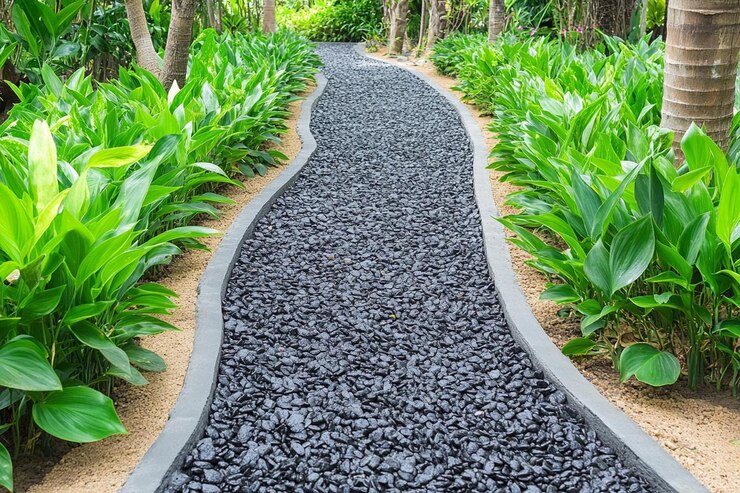In today’s environmentally-conscious world, making sustainable choices for landscaping, gardening, and playground surfacing is more important than ever. One material that has gained attention is rubber mulch, an eco-friendly alternative to traditional wood mulch. Derived from recycled tires, this durable material has numerous applications, providing a safer, longer-lasting solution for both home gardens and public playgrounds. In this article, we will explore the many benefits of rubber mulch and how it can transform your outdoor spaces.
Introduction
When planning a garden or playground, safety, longevity, and environmental impact are major considerations. Rubber mulch addresses all these aspects, offering a versatile and sustainable option. Unlike traditional wood mulch, which can degrade over time and need frequent replacement, rubber mulch stands up to harsh conditions, resists erosion, and provides a cushion-like surface ideal for playgrounds and walkways. But that’s not all—rubber mulch also contributes to eco-friendly practices by repurposing old tires, reducing landfill waste, and lowering maintenance efforts.
Let’s dive deeper into the various applications and benefits of rubber mulch, and how it can enhance the safety, aesthetics, and functionality of your outdoor spaces.
What is Rubber Mulch?
Rubber mulch is a landscaping material made from shredded or ground-up rubber, typically sourced from recycled tires. Unlike organic mulches, rubber mulch does not decompose, making it a long-lasting choice for both gardens and playgrounds. It comes in various colors and textures, designed to mimic the appearance of traditional mulches, while offering additional benefits in terms of durability, water conservation, and child safety.
Because it is produced from non-biodegradable rubber, rubber mulch remains intact for years, making it an ideal choice for projects requiring long-term ground coverage without the need for frequent replenishment. This longevity contributes to cost savings over time, as less mulch needs to be purchased and replaced.
Eco-Friendly Benefits of Rubber Mulch
One of the standout features of rubber mulch is its contribution to environmental sustainability. Repurposing old tires for mulch reduces the amount of waste that ends up in landfills, turning what would have been trash into a useful product. With millions of tires discarded each year, using them to create rubber mulch helps mitigate a significant environmental problem.
In addition to waste reduction, rubber mulch also contributes to water conservation. Traditional wood mulches absorb water, but rubber mulch allows water to pass through to the soil below, preventing moisture from being trapped at the surface. This helps retain soil moisture and reduces the frequency of watering, making it an ideal solution for drought-prone areas.
Rubber Mulch in Playground Safety
Safety is paramount when selecting materials for playgrounds, and rubber mulch excels in this area. Its soft, cushioned texture provides superior shock absorption, reducing the risk of injuries from falls. This is particularly important for play areas where children may be climbing, running, and jumping from playground equipment. According to safety standards, rubber mulch meets or exceeds the impact absorption requirements set by organizations like the Consumer Product Safety Commission (CPSC), making it a reliable option for public and private play areas.
Unlike wood mulch, which can scatter, splinter, or compact over time, rubber mulch retains its form, providing consistent protection. It also stays in place during heavy rains and high winds, ensuring that the playground remains safe and clean year-round.
Low Maintenance and Longevity
Rubber mulch is known for its long-lasting nature. Traditional organic mulches decompose, break down, and need replacement every year or two. Rubber mulch, on the other hand, remains intact for many years without requiring frequent maintenance or replacement. This makes it a cost-effective solution over time, especially for large landscaping or playground projects.
Moreover, rubber mulch resists compaction, unlike wood mulch, which can form dense layers that impede airflow and water absorption in the soil. Rubber mulch’s ability to stay loose and aerated ensures that plants receive the necessary nutrients and moisture while also preventing weed growth by blocking sunlight from reaching the soil.
esthetic Appeal of Rubber Mulch
Available in a wide range of colors and textures, rubber mulch can enhance the visual appeal of your garden or playground. While traditional mulch tends to lose its color and texture over time, rubber mulch holds its appearance for many years, thanks to its non-decomposing nature. The colors are designed to resist fading from sunlight, ensuring your landscaping stays vibrant year after year.
In terms of design flexibility, rubber mulch allows homeowners and landscapers to match or complement the color scheme of their home, garden, or playground. Whether you prefer a classic look with natural earth tones or a more playful, colorful arrangement for a children’s play area, rubbermulch provides options that suit various aesthetic preferences.
sing Rubber Mulch in Gardens
Rubber mulch is not just for playgrounds; it’s also an excellent choice for gardens. Its ability to conserve moisture by allowing water to pass through helps maintain healthy soil, reducing the need for frequent watering. Gardeners often struggle with weeds, but rubber mulch creates an effective barrier that inhibits weed growth, freeing you from the hassle of constant weeding.
Additionally, rubber mulch does not attract pests like termites or carpenter ants, which can be a problem with wood mulch. This makes rubber mulch a great choice for those looking to protect their plants and outdoor structures from infestations.
Is Rubber Mulch Safe for Plants?
One common concern is whether rubbermulch is safe for plants. Studies have shown that rubbermulch is generally safe for most plants as long as it is applied correctly. Like any mulch, it should be spread in a thin layer—no more than 2-3 inches deep—to allow for proper air circulation and water penetration.
However, it’s essential to avoid using rubbermulch in areas where you grow edible plants. While there’s no concrete evidence of rubber mulch leaching harmful chemicals into the soil, it’s better to err on the side of caution and use organic mulches in vegetable gardens.
Cost-Effectiveness of Rubber Mulch
Though the initial cost of rubbermulch is higher than traditional wood mulch, it proves more economical in the long run. Because rubbermulchdoesn’t need to be replaced as often, the overall cost over time can be significantly lower. Its durability also means less time spent maintaining your garden or playground, which translates into additional savings in labor and effort.
Moreover, the reduced need for weed control, watering, and pest management adds to its cost-effectiveness. By investing in rubbermulch, you may end up saving more than you would with cheaper, short-term solutions like wood mulch.
Rubber Mulch: An Ideal Landscaping Solution
Landscaping projects often require materials that are both functional and aesthetically pleasing. Rubbermulch fits the bill perfectly. Whether you’re creating pathways, filling in flower beds, or designing an eye-catching garden centerpiece, rubbermulch offers a versatile and durable solution. Its range of color options allows for creative landscaping designs that can enhance the visual appeal of any outdoor space.
Additionally, rubbermuhcl is easy to install. It can be spread just like wood mulch, but with the added benefit of not needing frequent replacement. Homeowners can enjoy their beautifully landscaped gardens with minimal upkeep, knowing that the mulch will retain its color and texture for years.
Rubber Mulch: Long-Term Environmental Impact
Beyond its immediate eco-friendly benefits, rubbermulch also has a positive long-term impact on the environment. By keeping tires out of landfills, it helps reduce the carbon footprint associated with tire disposal. Furthermore, its durability means that less material is required over time, reducing the overall demand for production and transportation. This can contribute to lower greenhouse gas emissions and a smaller environmental impact compared to organic mulches that require regular harvesting, processing, and replacement.
Conclusion
Rubbermulch offers a wide range of benefits, from its superior safety features for playgrounds to its cost-saving durability in gardens and landscaping. As a product made from recycled tires, it is also a sustainable choice that contributes to environmental conservation. Its versatility, longevity, and low maintenance requirements make it an excellent option for homeowners, landscapers, and public spaces alike.
Incorporating rubbe mulch into your next project can enhance both the aesthetics and functionality of your outdoor space, all while promoting eco-friendly practices. Whether you’re looking to create a safe playground, a thriving garden, or a beautifully landscaped yard, rubbe mulch is a smart, sustainable choice that delivers long-lasting results.
FAQs
What are the main benefits of using rubbe mulch?
Rubbe mulch offers superior durability, water conservation, and shock absorption. It’s eco-friendly, requires minimal maintenance, and retains its color and texture for years.
Is rubber mulch safe for plants?
Rubber mulch is generally safe for most plants, provided it is applied correctly. However, it’s best to avoid using it in vegetable gardens.
Can rubbe mulch be used in playgrounds?
Yes, rubbe mulch is widely used in playgrounds because of its excellent shock-absorbing properties, which help prevent injuries from falls.
Does rubbe mulch prevent weed growth?
Yes, rubbe mulch acts as an effective barrier to weeds by blocking sunlight from reaching the soil.
How long does rubbe mulch last?
Rubbe mulch can last for up to 10 years or more without needing replacement, making it a cost-effective long-term solution.
Is rubbermulch environmentally friendly?
Yes, rubbermulch is made from recycled tires, helping reduce landfill waste and promoting sustainability.











